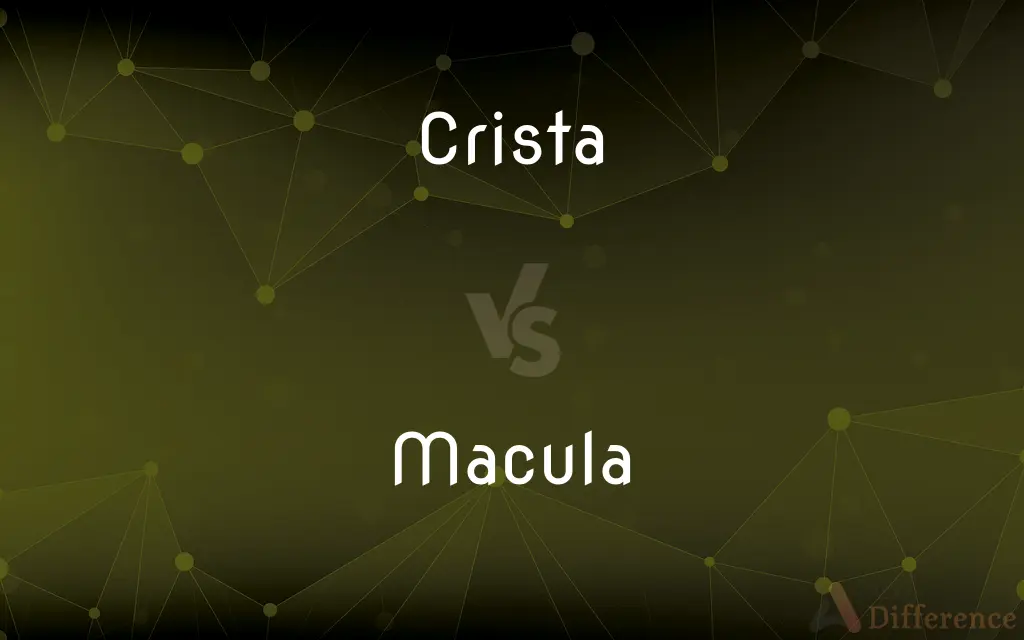Crista vs. Macula — What's the Difference?
By Tayyaba Rehman — Published on December 4, 2023
Crista are inner ear structures involved in detecting rotational movement, while Macula are structures in the inner ear sensing linear acceleration and gravity.

Difference Between Crista and Macula
Table of Contents
ADVERTISEMENT
Key Differences
The term "Crista" refers to a ridge-like structure, especially in biological contexts. On the other hand, the term "Macula" typically refers to a small spot or area, again primarily in biological references.
In the inner ear, the Crista are sensory epithelia located within the semicircular canals. They play a crucial role in detecting angular or rotational movements of the head. Contrarily, the Macula is found in the utricle and saccule of the inner ear, and they are responsible for detecting linear movements and the position of the head relative to gravity.
Both Crista and Macula have hair cells that get stimulated by motion. However, the mechanisms are different. In the Crista, the endolymph fluid in the semicircular canals moves due to head rotations, bending the hair cells. In the Macula, the otoconia (tiny calcium carbonate crystals) move over the hair cells when there's a change in head position or linear motion.
Though both Crista and Macula are involved in the vestibular system of the inner ear, their functions are distinct. Crista helps with balance during rotational movements, while the Macula helps discern vertical and horizontal linear movements.
Comparison Chart
Biological Structure
Ridge-like structure.
Small spot or area.
ADVERTISEMENT
Location
Semicircular canals of the inner ear.
Utricle and saccule of the inner ear.
Motion Detected
Angular or rotational movements of the head.
Linear movements & head position vs. gravity
Mechanism
Endolymph fluid moves due to head rotations.
Otoconia move over hair cells.
Primary Function
Helps with balance during rotational movements.
Discerns vertical and horizontal movements.
Compare with Definitions
Crista
A ridge or crest-like structure in biology.
The Crista of the mitochondria is essential for ATP production.
Macula
A spot or blotch, especially one on the skin.
The dermatologist examined the Macula on her arm.
Crista
Part of the inner ear detecting rotational movements.
The Crista helps us maintain balance when turning rapidly.
Macula
A small spot or area, especially on the skin or an organ.
A yellowish spot called the Macula lutea is in the retina of the eye.
Crista
A projection or fold in the inner structure of the mitochondria.
The Crista increases the surface area for cellular respiration.
Macula
A sensory region in the inner ear detecting linear acceleration.
The Macula senses when we move forward or upward.
Crista
An anatomical elevation or ridge.
The Crista galli is a projection of the ethmoid bone in the skull.
Macula
The central part of the retina responsible for detailed vision.
The Macula allows us to see fine details clearly.
Crista
Structures containing sensory hair cells in the semicircular canals.
The stimulation of the Crista helps signal rotational movement to the brain.
Macula
The part of the inner ear responsible for detecting gravity.
The Macula helps us understand our head's position in relation to the ground.
Crista
(Anatomy) A crest or ridge, as on the top of a bone.
Macula
An opaque spot on the cornea.
Crista
(Biology) One of the inward projections or folds of the inner membrane of a mitochondrion.
Macula
The macula lutea.
Crista
(cytology) Any of the internal compartments formed by the inner membrane of a mitochondrion, where many chemical reactions take place.
Macula
See macule2.
Crista
(dentistry) A dental crest.
Macula
(anatomy) An oval yellow spot near the center of the retina of the human eye, histologically defined as having two or more layers of ganglion cells, responsible for detailed central vision.
Macula
A small chamber of the inner ear of certain vertebrates filled with endolymph and containing an otolith.
Macula
A spot, as on the skin, or on the surface of the sun or of some other luminous orb.
Macula
A rather large spot or blotch of color.
Macula
In planetary geology, an unusually dark area on the surface of a planet or moon.
Macula
A spot, as on the skin, or on the surface of the sun or of some other luminous orb; called also macule.
Macula
A rather large spot or blotch of color.
Macula
A cooler darker spot appearing periodically on the sun's photosphere; associated with a strong magnetic field
Macula
A yellowish central area of the retina that is rich in cones and that mediates clear detailed vision
Macula
A patch of skin that is discolored but not usually elevated; caused by various diseases
Common Curiosities
How does the Crista function in the ear?
The Crista in the inner ear detects rotational or angular movements of the head.
Where can we find the term "Macula" used in biology?
The term "Macula" can refer to a spot on the skin, retina, or a sensory region in the inner ear.
What role does the Macula play in our vision?
The Macula, located in the retina, is responsible for our central, detailed vision.
Can damage to the Crista affect balance?
Yes, damage to the Crista can disrupt the sense of rotational balance.
Are Crista and Macula related in function?
Both are related to balance and spatial orientation but in different ways; Crista detects rotation while Macula senses linear motion and gravity.
Do both Crista and Macula contain hair cells?
Yes, both have hair cells that get stimulated by motion, but they detect different types of movements.
How does the Macula relate to age-related vision issues?
Macular degeneration, linked to aging, affects the Macula in the retina, leading to central vision loss.
Can diseases affect the functioning of the Crista?
Yes, certain conditions, like vestibular neuritis, can impact the Crista's function.
How does the Macula help with balance?
The Macula detects linear movements and the head's position relative to gravity.
Is the Crista related to the cochlea?
While both are in the inner ear, the Crista is for balance, and the cochlea is for hearing.
What is the Crista?
Crista is a ridge-like structure, particularly in biology, such as in the inner ear or mitochondria.
What happens when there's a problem with the Macula in the retina?
Issues with the Macula can lead to difficulties in seeing fine details and central vision.
What's the significance of the Crista in mitochondria?
The Crista in mitochondria increases the surface area for cellular respiration, aiding ATP production.
Are Crista and Macula structures exclusive to humans?
No, many vertebrates have similar structures in their inner ears for balance and spatial orientation.
How does the Macula in the ear differ from the one in the eye?
The Macula in the ear detects linear motion and gravity, while the one in the eye is related to central vision.
Share Your Discovery

Previous Comparison
CDMA vs. WCDMA
Next Comparison
Whipping Cream vs. Heavy CreamAuthor Spotlight
Written by
Tayyaba RehmanTayyaba Rehman is a distinguished writer, currently serving as a primary contributor to askdifference.com. As a researcher in semantics and etymology, Tayyaba's passion for the complexity of languages and their distinctions has found a perfect home on the platform. Tayyaba delves into the intricacies of language, distinguishing between commonly confused words and phrases, thereby providing clarity for readers worldwide.












































